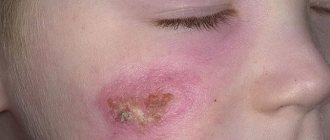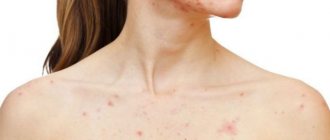Herpes on the body of a child is much more common than in adults, which is due to the widespread prevalence of the virus. Once it enters the body, it remains there for life; the main thing is to control the situation, since a weakened immune system will constantly provoke its activation. The herpes virus affects all organs, but in children it most often manifests itself on the skin and mucous membranes.
Herpes on the body of a child is much more common than in adults, which is due to the widespread prevalence of the virus.
Types
There are eight known herpes viruses that infect people.
Herpes simplex virus
HSV-1 usually causes sores around the mouth, and HSV-2 causes blisters on the genitals, but these two types of virus can be associated with both sets of symptoms.
Varicella zoster virus
This type causes chickenpox. The virus can also cause a recurring skin infection called herpes zoster or shingles. Shingles occurs when the dormant varicella zoster virus from the initial attack of chickenpox is reactivated. Like HSV-1, herpes zoster likes to infect skin and nerve cells. Because a number of nerve cells are often affected, shingles is usually much more serious than a relapse of HSV. The lesions appear in the form of a stripe appearing on one side of the body, and are often accompanied by tingling, itching, and severe pain.
Epstein-Barr virus
The virus is the main cause of infectious mononucleosis. The disease most often affects older children. Infection in early childhood is common but often undiagnosed.
Cytomegalovirus
CMV is also a cause of mononucleosis. In children with a healthy defense system, the virus may not even cause any symptoms. In immunocompromised individuals, symptoms will vary according to the age and immune status of the child at the time of or after infection. This is a common cause of congenital infections.
Human herpes virus 6
HHV-6 causes roseola (a disease characterized by high fever and skin rash in young children) and many other diseases associated with high fever at this age. This infection accounts for many cases of infantile febrile seizures.
Human herpes virus 7
Closely related to HHV-6 is HHV-7. Like other types of herpes, they are very common: most people in the world have been infected with them. HHV-7 is also the cause of roseola, but it is unclear what other clinical manifestations this virus causes.
Human herpes virus 8
HHV-8 was recently discovered in tumors called Kaposi's Sarcoma. They occur in patients with AIDS. They are very rare in healthy people. HHV-8 can also cause other types of cancer, including lymphomas (cancer of the lymph nodes) associated with AIDS.
What factors can trigger the development of the disease?
A number of factors can influence a child’s infection with the herpes virus, including the following:
- reduced immunity;
- poor nutrition;
- lack of vitamins in the body;
- hypothermia;
- exposure to ultraviolet radiation;
- drying out of the mucous membrane;
- increased physical activity;
- skin lesions;
- frequent colds of an infectious nature;
- stressful situations in a child’s life that cause his nervousness.
Most often, infection with a herpes infection occurs as a result of a violation of the temperature regime in the room where the child is located during the winter season. The situation is aggravated if the child is young and has a weakened immune system. In this case, the disease begins to progress rapidly: significant areas of the body and mucous membranes are affected. The weaker the body's defenses, the more difficult herpes is, no matter in what form it appears.
Routes of infection
Most children are protected by their mothers' antibodies. However, this protection is sometimes not enough. Infants usually contract herpes in one of two ways: vertical or horizontal transmission.
The vertical route involves transmission of the virus through the birth canal. This can happen if the mother has a genital herpes infection.
Remember that HSV-1 and HSV-2 can affect the genitals. Even when the mother is not having an outbreak, the virus can be released from cells in the birth canal and transmitted to the baby, usually through the eyes or abrasions. This is the most common form of transmission of the virus in newborns.
In some very rare cases, the virus can actually be passed through the placenta to the baby during pregnancy. This is called “intrauterine infection” and can cause spontaneous abortion, growth retardation, and hydrocephalus. Intrauterine infection usually occurs only when the mother is primarily infected with herpes while pregnant.
Horizontal transmission involves infection from another person after birth. The source could be a shared toy, cup or utensil. A kiss from an infected relative or friend can also lead to infection.
Finally, herpes can be transmitted through a mother's breast milk if the mother is infected.
Video “Herpesvirus infections and cytomegalovirus”
Gynecologist Anna Sotsuk tells how to avoid damage to the fetus during pregnancy in this video. Author of the Vi Feron channel.
Do you have any questions? Specialists and readers of the KROHABABY website will help you ask a question
Was this article helpful?
Thank you for your opinion!
The article was useful. Please share the information with your friends.
Yes (100.00%)
No
X
Please write what is wrong and leave recommendations on the article
Cancel reply
Rate the benefit of the article: Rate the author ( 1 vote(s), average: 5.00 out of 5)
Discuss the article:
Symptoms
Manifestations of herpes depend on the severity of the infection, its location, and the stage of the disease. For the most part, herpes prefers mucous membranes. However, any area of the body can be affected by the virus.
Diseases of the oral cavity and pharynx
Herpetic gingivostomatitis (a disease of the mouth and gums) most often affects children from six months to 5 years. This is a very painful condition with sudden onset, pain in the mouth, drooling, refusal to eat or drink, and fever of up to 40.0 - 40.6 ° C. The gums become noticeably swollen and sores can develop throughout the mouth, including the gums, lips , tongue, palate, tonsils, pharynx and skin around the mouth.
In older children and adolescents, the initial stage of herpes may manifest itself as pharyngitis and tonsillitis, rather than gingivostomatitis. Signs of the virus may be indistinguishable from those of streptococcal pharyngitis and include fever, malaise, headache, sore throat and white plaques on the tonsils. The course of the disease is usually longer than with streptococcal pharyngitis.
Cold on the lips
This disease is the most common manifestation of relapses of HSV-1. The lips are most often affected, although lesions sometimes appear on the nose, chin, cheek or oral mucosa.
Skin diseases
In a healthy child or adolescent, herpetic skin diseases are usually the result of skin trauma with macro- or micro-abrasions and infection with infectious secretions. Pain, burning, itching or tingling often precedes a herpetic eruption. Cutaneous herpes infection results in multiple separate lesions and affects a large surface area.
Herpetic whitlow
This term is usually used to refer to herpetic diseases of the fingers and toes. Among children, this condition is most often seen in infants and toddlers under 3 years of age with an oral herpes infection who frequently put their hands in their mouth.
The onset of the disease is indicated by itching, pain and inflammation 2 to 7 days after exposure. The cuticle becomes inflamed and sensitive. The lesions and associated pain usually persist for about 10 days, followed by rapid improvement and complete recovery after 18 to 20 days.
Genital herpes
Classic primary genital herpes may be preceded by a short period of burning and tenderness before blisters develop on the mucous membranes or keratinized skin of the genitals, and sometimes around the anus or on the buttocks and thighs. The blisters (vesicles) on mucosal surfaces are short-lived and rupture, forming small, tender ulcers covered with a yellowish-gray exudate and surrounded by an inflamed border.
Patients may experience quite severe inflammation of the urethra (urethritis) and urinary dysfunction (dysuria). Significant local pain and systemic symptoms such as headache, fever and myalgia are common. The course of treatment for classic primary genital herpes from onset to complete healing is 2 to 3 weeks.
Repeated genital herpes is usually less severe and shorter-lived than the initial infection. Some patients experience previous pain, burning and tingling in the area where blisters subsequently develop.
Genital diseases caused by HSV-1 and HSV-2 are indistinguishable, but HSV-1 causes significantly fewer subsequent episodes of recurrent infection; therefore, knowing which virus causes the infection has important prognostic implications.
Eye diseases
Herpes can affect the conjunctiva, cornea or retina. Conjunctivitis or keratoconjunctivitis (inflamed conjunctiva and cornea) is usually unilateral. The conjunctiva appears swollen, but there is rarely purulent discharge. Vesicles can be seen along the edges of the eyelid and on the skin around the eyes. Patients usually develop a fever.
Diseases of the central nervous system
Herpetic encephalitis is almost always caused by HSV-1. The disease may manifest as nonspecific symptoms, including fever, headache, stiff neck, nausea, vomiting, and convulsions. Uncontrolled disease progresses to coma and death in 75% of cases.
Herpes in newborns
Neonatal herpes is never asymptomatic. Its clinical presentation reflects the timing of infection, the site of entry of infection, and the extent of spread. Infants with intrauterine infection usually have vesicles and scars on the skin, keratoconjunctivitis, and microcephaly or hydrocephalus. Few infants survive without treatment, and those who are given treatment usually have serious consequences.
Infants infected during or after birth have 1 of the following 3 types of illness:
- disease localized to the skin, eyes or mouth;
- encephalitis with or without skin, eye and mouth disease;
- spread of infection involving several organs, including the brain, lungs, liver, heart, adrenal glands and skin.
What does herpes look like on a child's body?
Stage No. 1: Redness of the skin (Prodromal stage)
As soon as the herpes virus comes into contact with the skin, it causes a tingling sensation and slight tightening of the affected area. The affected area of skin then turns red. After a few days (1 - 2 days), the child may experience severe itching and/or irritation of the affected area. Some people complain of pain in this area.
Stage No. 2: Inflammation and swelling
There are not many people who can recognize the prodromal stage, so rapid diagnosis at this stage is rare. If the early signs of a herpes outbreak, such as redness and itching, are not assessed and treated at the right time, then the area of skin becomes swollen and inflamed. Although the swelling of the affected area may be severe, in some cases it is not noticeable.
Stage #3: Vesicle Eruption
Soon, small red bumps appear at the site of swelling, which transform into small bubbles filled with liquid. This is the stage when noticeable symptoms of herpes first appear. Blisters are clear, whitish or reddish in color, appearing in groups or scattering (rarely). The blisters, which are tender and painful to the touch, usually remain for 2 days.
Stage No. 4: The appearance of ulcers
This stage lasts only one day. Once the blisters rupture and begin to leak fluid, moist ulcers develop in the affected skin area. This is the most painful and contagious stage of herpes. Wet ulcers are reddish, look like fresh wounds and are very sensitive to the touch. They rise slightly above the level of the surrounding skin, which is not affected by inflammatory changes.
Step #5: Drying and crusting
This stage begins the initial phase of ulcer healing. As wet sores begin to heal, a dry scab forms and eventually hardens. When the sores completely disappear, new skin develops under the scab. Duration is 2 - 3 days. This stage is characterized by increased dryness, pain and itching. Excessive dryness can cause skin cracks and bleeding.
Stage #6: Complete Healing
Over the next few days, the crust on the skin dries and gradually falls off, leaving new skin underneath. Herpes sores usually heal without scarring of the skin. However, a scar may remain if the scabs are removed before complete healing. In case of scarring, an ointment for external use against scars is used. This last stage of herpes can last 4 days. Painful to the touch, the blisters usually remain for 2 days.
Diagnosis
It is established using a general clinical picture and examination of smears, scrapings and prints from areas affected by the virus. For detection, 12-day-old chicken embryos, contaminated cell cultures and experimental animals are used. Identification of the virus is carried out using electron and light microscopy.
Proof of the existence of the virus is the identification of its antigens in body cells and biological fluids. Antigens are determined by immunofluorescence methods with monoclonal or polyclonal antibodies. Or using ELISA analysis. A new modern method for detecting herpes is PRC (polymerase chain reaction).
Treatment
In children, herpes will clear up without treatment within about one to two weeks. There are a number of ways to speed up the healing process.
Children at risk of complications are given antiviral therapy, often in hospital. To shorten the course of the disease and reduce the likelihood of spreading the virus, the doctor will prescribe oral antiviral drugs or topical agents. Systemic medications help shorten the time of illness, and creams and ointments reduce symptoms. Three antiviral drugs are available to treat herpes, namely acyclovir, valacyclovir and famciclovir. All 3 are available for oral use, but only acyclovir is available as a suspension.
- Acyclovir has the lowest bioavailability and therefore requires more frequent dosing.
- Valaciclovir and famciclovir have very good oral bioavailability and are taken once or twice daily.
Acyclovir and penciclovir are also available in ointment and cream forms, but they provide limited benefit to patients with recurrent mucocutaneous herpes infections.
Only acyclovir is prepared as a solution for intravenous administration.
Early initiation of treatment results in maximum therapeutic benefit. All 3 drugs are safe for use in children.
Other home treatments include using a cold compress or taking a pain reliever.
Summary for parents
Herpes is a widespread viral disease. It is difficult to protect a child from infection. But you can prevent activation of the virus and the development of clinical manifestations of infection by strengthening the child’s immunity.
If manifestations of herpes simplex occur, it is necessary (and possible) to alleviate the child’s discomfort at home, using the recommendations of official and traditional medicine outlined in the article.
Only a doctor should select special antiviral drugs for oral administration. But complete liberation of the child’s body from the herpes virus is impossible at the current level, even with antiviral therapy.
Prevention
Standard prevention of herpes is hygiene and protecting the child from hypothermia. Prevention of neonatal infection is somewhat more difficult. There are a number of measures:
Before planning a pregnancy, a woman should be examined. If you have herpes, it should be treated:
- The gynecologist should regularly monitor the condition of the birth canal of a pregnant woman, since herpes may recur during pregnancy;
- If an outbreak occurs before the 36th week of pregnancy, the expectant mother will be prescribed standard antiviral therapy with acyclovir. After such treatment, childbirth can occur naturally;
- If the infection appears after 36 weeks of pregnancy, a caesarean section is recommended.
After birth, the main preventive measure is long-term breastfeeding. You should not breastfeed your baby if the herpes rash is directly on her.
In the future, the child should be protected from contact with carriers of the infection. Do not allow him to come into contact with people with characteristic lip ulcers.
Diagnostics
Diagnosis of herpes in children is carried out on the basis of a detailed examination and interview of young patients. If there is a suspicion of a herpes infection, parents should contact their pediatrician, who can conduct an examination himself, or may refer the child to a dermatologist for additional advice. The disease is determined by detecting herpetic blisters located inside the epidermis, and taking into account the patient's complaints of weakness, drowsiness, and pain in the areas where the rashes are located. Confirmation of the diagnosis is carried out through laboratory tests by identifying viruses in the contents of the vesicles. In some cases, it is advisable to conduct a serological reaction to detect the presence of a herpes virus and use other examination methods. For example, a RPHA blood test in some cases makes it possible to diagnose a disease in a child that occurs in a latent form.
Detection of neonatal herpes, the development of which occurs in utero, consists of monitoring the condition of a pregnant woman who has herpes. An important point is the form of the disease: primary or recurrent. Such tracking when a child is born allows you to quickly identify the cause of the disease.
Clear signs of herpes are the accompanying manifestations: convulsions and sepsis. During the examination, it is important to identify placental pathologies, the condition of internal organs and the brain. To clarify the situation, ultrasound and brain tomography can be used.










